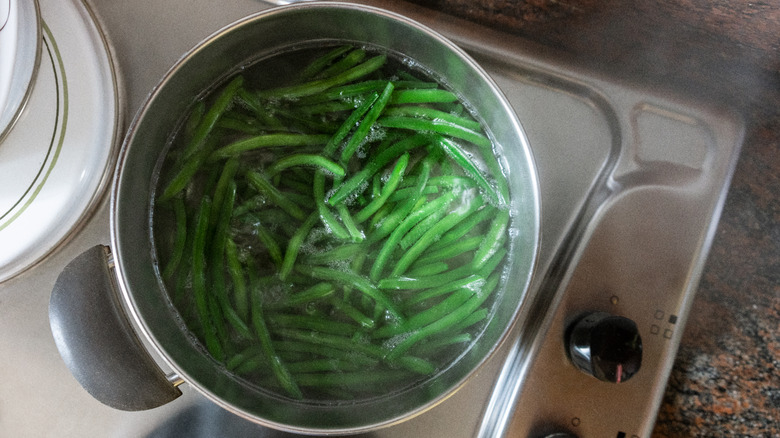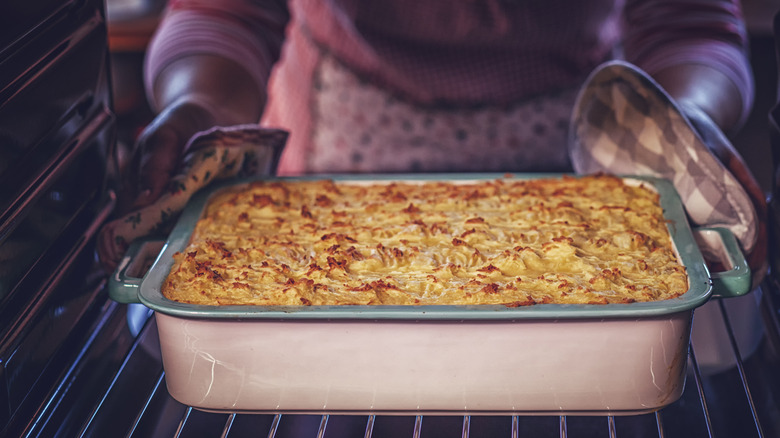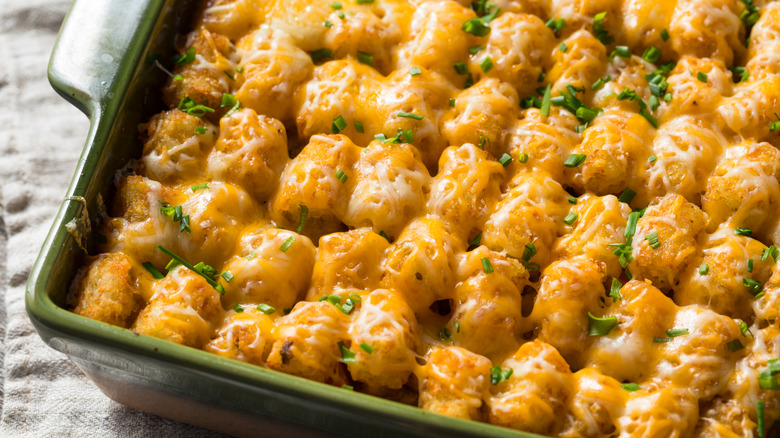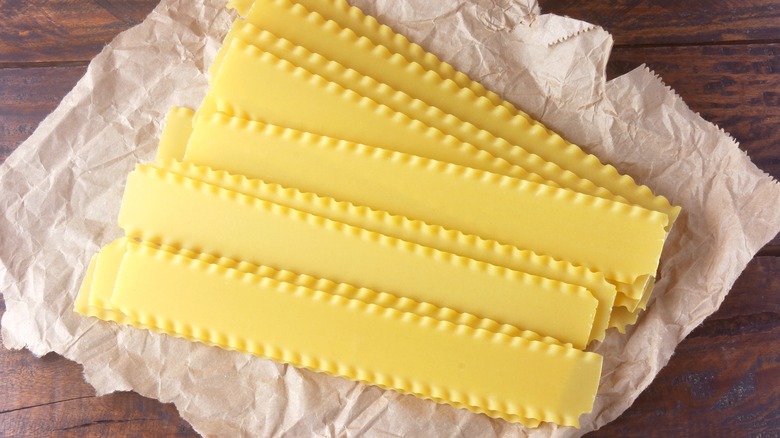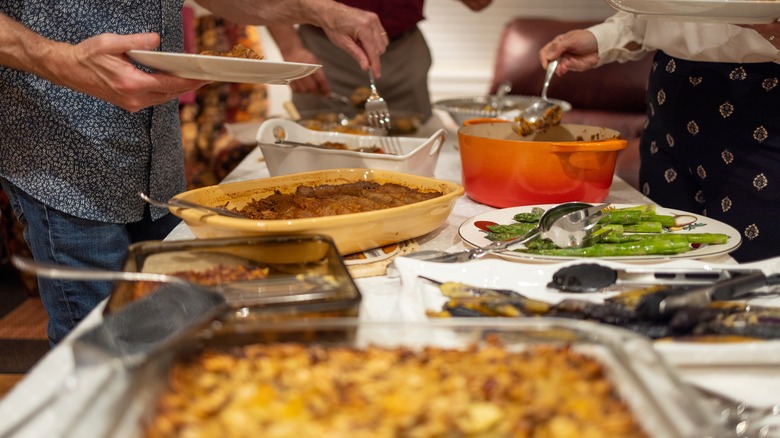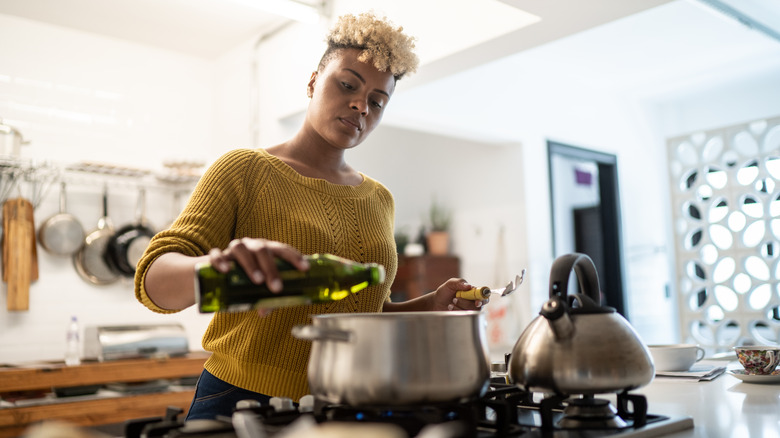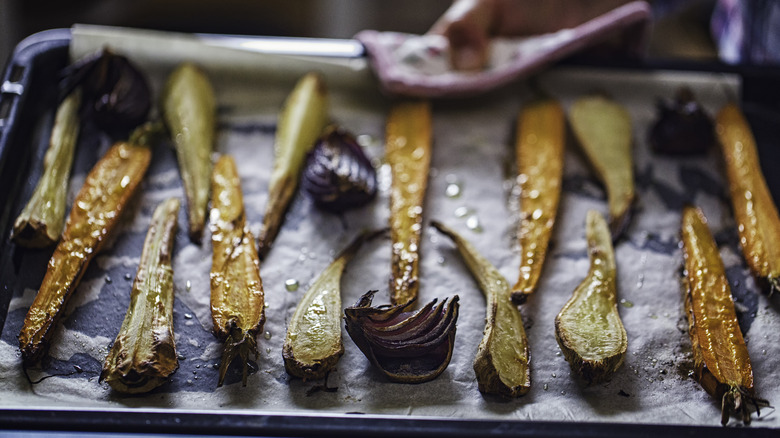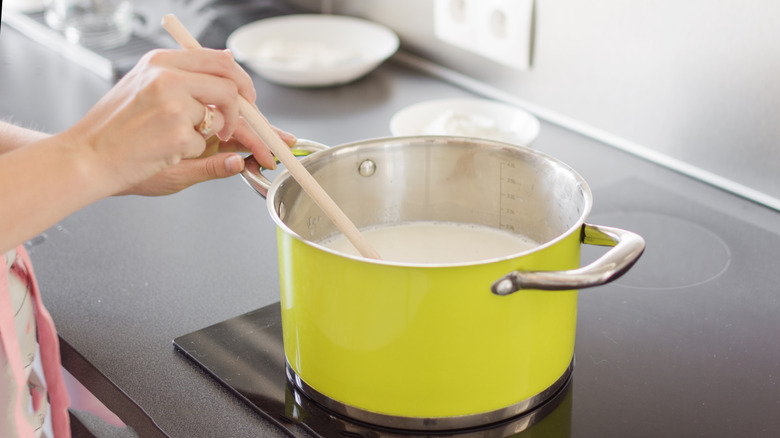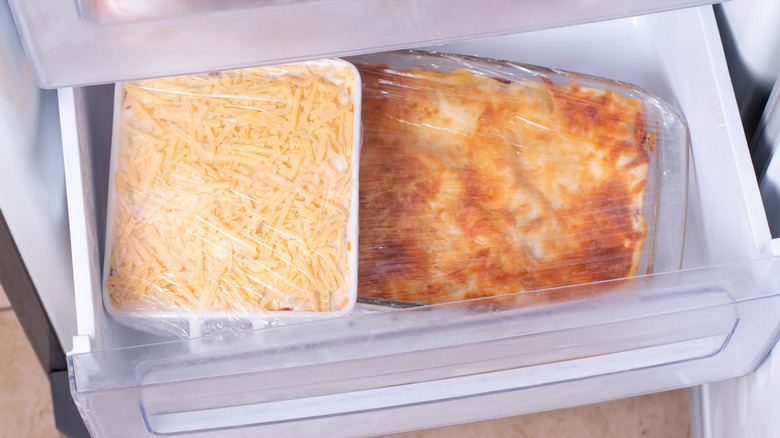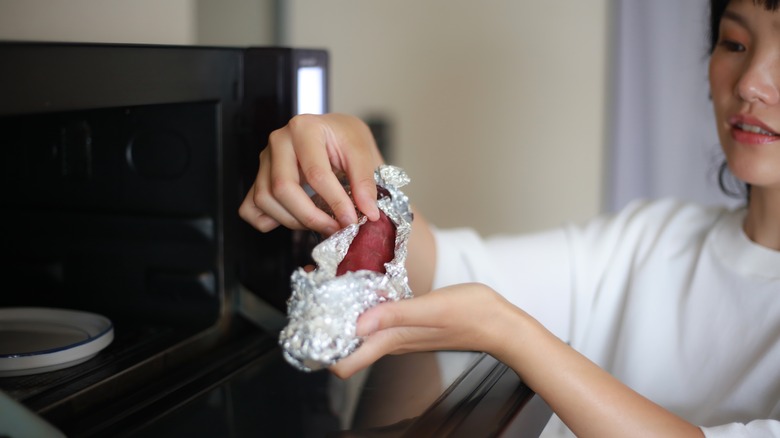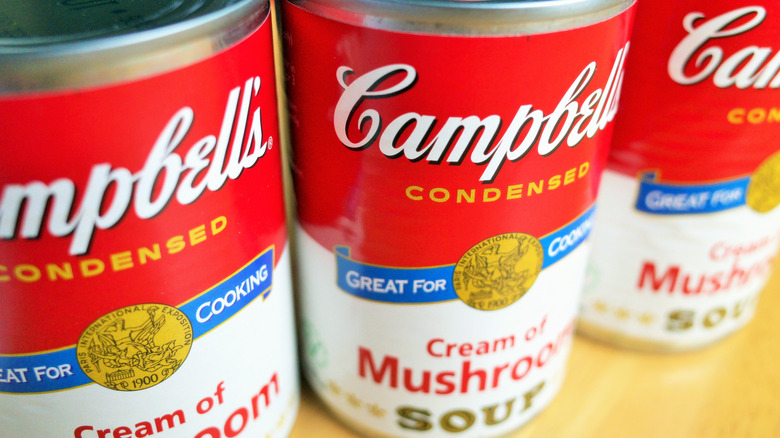Casserole Secrets From Celebrity Chefs
Casseroles are simple. You likely have a few favorites that have been passed down through your family. Maybe they are tied to the region you grew up in (like a variation on the tater tot casserole that's popular in the Midwest). Casseroles are known as low-cost, working-class food, combinations of affordable, tasty ingredients that, all together, form something greater than their parts. You don't expect to eat a casserole when you go out for a nice dinner, but there's still something wonderfully nice and comforting about one. You know exactly how to make it, and there's not much room for improvement.
However, what if there was room for improvement? Turns out, even your favorite celebrity chefs, who all likely have plenty of skill and plenty of money to make a dinner that goes beyond the humble casserole, can't resist the allure of this American staple — and they have a few secrets that can help upgrade your next casserole.
Don't limit your casseroles to the oven
When you think of a casserole, you likely have a good idea how to cook it. No matter what the ingredients, a casserole is compiled in an aptly named casserole dish, and then you pop the whole thing, sometimes covered with a layer of aluminum foil, into the oven for about half an hour or so, maybe an hour, tops. This process is fine in the winter months when you don't really mind turning on your oven and heating up your house, and it's fine when you're only making the casserole, and your oven is free and clear. But what about in the summer, when you can't stand the thought of adding more heat into your home, or around the holidays, when you might need to use your oven for other dishes?
That's when a tip from chef and TV host Alex Guarnaschelli can come in handy. Food Network favorite Guarnaschelli makes a green bean casserole on the stovetop, cooking the green beans and the mushroom sauce separately, combining the two, and then topping the mixture with fried shallots. You get the creamy casserole base and the crunchy topping, but without ever turning on your oven. This is a tip that's not just for green bean casserole; it can also work with just about any casserole you like.
Go beyond your typical toppings
A crunchy topping is a requisite for a good casserole. You have all that creamy goodness in the actual casserole body, but then the crunchy topping adds much needed texture. There are a lot of topping options, with favorites being breadcrumbs and french fried onions, but you don't need to settle for the classics if you want to mix things up a little.
In a Facebook post, celebrity chef Alex Guarnaschelli suggests swapping your french fried onions for other toppings the next time you make a green bean casserole — more specifically for barbecue potato chips. However, if you have neither french fried onions nor potato chips of any kind on hand, there are plenty of other toppings you can add to a casserole. Options include crushed cereal like corn flakes or Grape Nuts, pretzels, crackers (and don't just settle for buttery crackers; look at all your options, including cheese crackers, oyster crackers, and beyond), toasted nuts, or bacon. Get creative with it!
Mix up the classics
If your casserole recipes are family favorites that have been passed down through the generations, you might feel as if there isn't much room for innovation or creativity. Your family likes their casseroles one way and one way only. Your staple casseroles have always been made the same way — doing things any other way would simply be blasphemy.
However, you can get a little adventurous in the kitchen the next time you cook up a classic casserole, as celebrity chef Andrew Zimmern recommends. The chef likes his own take on a tater tot hotdish and recommends you make it (though he does point out that there's technically a difference between a hotdish and a casserole, and it's all about the layers — but that's up for debate, depending on who you ask). That said, he also encourages home cooks to put their own spin on the dish and acknowledges that many do, swapping out veggies and other ingredients for different textures and flavors. The point? Casseroles are often forgiving enough and versatile enough that you can mix things up every once in a while.
Don't pre-cook your pasta
Putting together a pasta-based casserole? If you're specifically making a lasagna (which, yes, is a casserole), celebrity chef Ina Garten recommends not pre-cooking your lasagna noodles. No, she doesn't advocate that you take a quick shortcut and buy the no-boil noodles. Instead, she suggests that you soak your lasagna noodles in hot water while you're cooking up the rest of your lasagna ingredients, like your protein of choice and sauce, if you're making it from scratch. Then you just drain the noodles and layer them into your lasagna like normal.
This secret to a better casserole combines the benefits of no-boil lasagna noodles and traditional lasagna noodles. Once in the oven, the noodles cook faster than no-boil lasagna noodles because they've been soaked and softened. However, they also don't require all that extra time during pre-baking, like traditional noodles do, because there's no need to bring a pot of water to a boil and then cook the noodles until they're finished. It only takes about 15 minutes to soak the noodles, but make sure to give them a quick stir or two, while soaking, to prevent sticking.
Don't overlook casseroles when entertaining
When you think of casseroles, you likely think of them as a simple, easy, affordable meal for weekdays or for cooking in big batches on the weekends so you have them in the freezer, at the ready, the next time you're just not in the mood to cook after the workday. However, don't overlook casseroles for entertaining, too, encourages former "Top Chef" winner Kelsey Barnard Clark in an interview with Southern Kitchen.
Casseroles are a perfect pick for get-togethers and gatherings, as they don't require you to hover over the stove or stick by the grill the entire evening, Barnard Clark noted. In fact, you can even make your casseroles ahead of your event and then simply pop them in the oven when it's time to eat. You get to enjoy your party, and your guests still get to enjoy a delicious, comforting, hearty meal. (Worried that a casserole won't exactly impress your guests? Consider making a favorite, crowd-pleasing casserole like a pepperoni pizza casserole, a spaghetti and meatballs casserole, or a chicken and rice casserole.)
Cook all your ingredients before baking
Are you in a time crunch? Don't have an hour to wait for your casserole to cook in the oven? If you want your casserole to come together faster than ever, follow chef and TV host Rachael Ray's tip and cook all of your casserole ingredients separately, so that the overall casserole needs to spend less time in the oven. For recipes like Ray's chicken, sausage, pepper, and onion casserole, she cooks the pasta, meat, and veggies before assembling everything in a casserole dish, so that all that's needed is a few minutes under the broiler so that the cheese on top can melt and brown.
You can use this tip with just about any casserole. When you've cooked all your ingredients and compiled them, just crank up the heat in your oven and let the casserole cook just long enough so that the sauce gets all bubbly, any cheese (if the recipe requires it) melts, and your topping browns. Under the broiler, this should require minimal time.
Use other root vegetables in potato-based casseroles
A lot of casseroles are potato-based. You've got mashed and loaded potato casseroles that combine potatoes with cheese and other, typical baked potato toppings; breakfast potato casseroles with bacon and more cheese; scalloped potatoes; and more. Casseroles and potatoes just go well together! However, if you're short on potatoes or just want to incorporate other ingredients into your dish for health reasons (let's face it — while potatoes come with health benefits, there are healthier vegetables out there), chef Alex Guarnaschelli encourages you to swap out some of the potatoes in your casserole for other root vegetables.
Guarnaschelli uses an array of other ingredients, including turnips, sunchokes, and rutabagas, in place of mashed potatoes in her recipes. In larger dishes like casseroles that include an variety of other flavors and textures, the differences between a potato and other root vegetables aren't quite as noticeable as they would be otherwise.
Heat your milk before making a roux
A roux is a necessity for many dishes. Any time you're making a sauce, a roux will help thicken things up. As such, saucy casserole dishes will require a roux as well. Think creamy, cheesy baked mac 'n cheese or a saucy tuna or green bean casserole. However, while a roux is simple — you just cook flour in butter to form a paste and then start adding your sauce ingredients, like milk or broth — you can improve your casserole's roux base with one tip.
For casserole sauces that require a roux and milk base, chef Ina Garten recommends that you heat your milk before adding it to the roux. Not only does this make for quicker cooking, as you won't need to bring cold milk to a higher temperature, but you'll also avoid messy spattering as the cold milk hits your hot pan and hot roux. Just be careful that you don't burn your milk while heating it — and if you do, try adding some salt to help neutralize the scorched smell and taste.
Assemble casseroles ahead of time
Casseroles are all about cost savings and convenience. While many casseroles are easy enough to assemble and pop into the oven the day you plan to eat them, if you want to save yourself even more time, consider assembling your casseroles even further in advance, for quick cooking and minimal work. Country music star and cookbook author Trisha Yearwood, for example, assembles her breakfast sausage casserole the night before she wants to cook it for an easy morning meal over the holidays.
However, you don't have to necessarily cook your casserole the next day in order to enjoy the fruits of your (advance) labor. If you want to assemble a casserole, freeze it, and then cook and eat it much, much later, you can do so. Casseroles with cooked protein or no protein can be frozen before baking. They will last for about three months in the freezer. When you're ready to eat them, move them to the refrigerator a day in advance to thaw. Pro tip: Don't freeze casseroles that contain ingredients, like sour cream or cottage cheese, that don't freeze well overall.
Microwave potatoes for your sweet potato casserole
Yes, you can make a sweet potato casserole with canned sweet potatoes. However, if you want to level up your sweet potato casserole with fresh sweet potatoes but still don't want to spend a significant amount of time cooking those sweet potatoes before assembling your casserole, celebrity chef Damaris Phillips has a casserole secret that may work for you.
She told the Courier Journal in Louisville, Kentucky, that you can easily microwave your sweet potatoes for the casserole instead of cooking them on the stovetop or baking them. It only takes six minutes in the microwave compared to the estimated hour this process will take in the oven. Then, you can assemble the sweet potato casserole and finish it off with a blow torch in order to melt and brown your marshmallows (or brown your meringue, which is what Phillips uses to top her sweet potatoes). No oven required. If you decide to cook your potatoes in the microwave, just be sure to clean and dry them and then poke several holes in the potatoes' skin before cooking.
Skip the canned soup
Just about every casserole dish includes a can of "cream of" something. Whether it's cream of chicken, cream of mushroom, cream of celery, or cream of cheese, you name it, these canned soups find a place in many a casserole recipe — and for good reason. Canned soup adds easy creaminess to a casserole without requiring a roux made from scratch. Instead, you get a simple sauce just by opening a can.
However, Food Network's Molly Yeh encourages you to bypass the canned soup the next time you make a casserole and to take the extra effort to make your creamy sauce from scratch, as she told Today. She promises that the process is not difficult. All you have to do is make a roux by blending equal parts fat and flour in a saucepan, cooking it into a paste, and then adding your liquid of choice, whether that's milk (or a non-dairy alternative), broth, or even tomato sauce. Then, season the sauce to taste.

